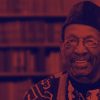
George Talusan / George Talusan
LaTanya Grant speaks to the rally. Her cousin Jermaine Carby was shot dead by Peel police in Brampton in 2014.
Sleeping in shifts, surviving on donations, and singing through it all, demonstrators have stood for almost two weeks straight under the banner of Black Lives Matter.
For organizers, those three words form a movement steeped in the language of revolution and resistance.
Started in Toronto and other cities in the wake of the shooting death of Michael Brown in the U.S. in 2014, the black liberation effort culminates, participants say, with one message: We’re here. For now “here” is literally outside police headquarters at 40 College St. where camp was set up on March 20.
The occupation cropped up in response to the reduction of Afrofest to one day (a decision since reversed) and the SIU’s decision not to press charges in the shooting death of Andrew Loku.
But those at the tent city say it is built on a more basic demand: acknowledge the lives of black people. The art, the stories, the struggles.
“When you dig into it, at the root of it all is pain. As black people, how does it make us feel to shout out over and over that our lives matter?” said supporter Viviane Rutabingwa at the camp on Wednesday.
“Do I even have to say that? Sometimes when I scream it out, I say it to myself, to remind myself.”

George Talusan
Black Lives Matter co-founder Alexandria Williams.
For Alexandria Williams, one of the group’s co-founders, it’s a space for community healing and building, while also addressing the state’s inattention to black people, she said.
“It’s transformed into a space where a community can outline what they need,” she said.
The movement has spawned a mixtape (“Music’s already been a big part of the resistance and revolution,” said protester Coyote Watson), a summer camp, and visual art plastered around the site.
“To paraphrase Amilcar Cabral: every generation must take up the struggle for black liberation in their own time and with the tools that are available to us,” said Ryerson professor Grace-Edward Galabuzi as he presented a statement of solidarity signed by almost 100 black educators at the tent city site on Friday morning.
After almost two weeks, frustrated with a lack of response from officials, the movement recently stepped up its tactics.
Supporters visited Premier Kathleen Wynne’s home Thursday night. Wynne wasn’t home at the time, but the flowers, cheese and tent the group left prompted a visit from the police hazmat team.
Speaking to reporters on Friday, Wynne admitted the action “unnerved” her partner.
“But having said that, I understand the concerns in the community,” she said. She added that Culture Minister Michael Coteau, recently appointed responsible for the province’s anti-racism directorate, would be meeting with the group.
On Friday demonstrators converged on city hall, where councillors voted unanimously to pass a motion asking the province to review policing and the SIU with a focus on anti-racism.
The vote was met with applause, but frustrations soon boiled over and demonstrators left the chamber chanting and demanding the name of the officer who shot Loku.
Ahead of the vote, Mayor John Tory spoke about the protests publicly for the second time since the camp cropped up.
Deeming the visit to Wynne’s house “inappropriate,” he said he has reached out for a meeting since the occupation started, but insists it be in private in the name of constructiveness, Tory told reporters.

George Talusan
Dancing and music have been almost constant during the occupation; the mood stays upbeat despite the hardships many participants say they’ve faced because of racism.
Not much about the tent city occupation has been private. The group has been demonstrating in public and living in public and wants the response to be in public, says Pascale Diverlus, a co-founder of Toronto’s Black Lives Matter and a core organizer of the tent city.
“We’re not just being simply rowdy because we’re anarchists. A lot of us have day jobs. I have a master’s degree. We’re not people who are quote-unquote bums. This is important,” Rutabingwa said.
The days and nights at the camp are peaceful and seem at times quite jovial.
During the day, the construction noise across the street is more disruptive for anyone walking by. At 4 a.m.the music Fran’s diner — open 24 hours — plays on the sidewalk up the street is louder than any sound coming from the camp.
After more than a week of the encampment, local businesses the Star spoke with weren’t noticing or minding the new neighbours.
“If it’s something they’re trying to change for the best, I think it’s maybe a good thing,” said Albert Anidjar, an optician doors down from police headquarters.
Passing cars and bicycles offer honks and dings of support, posters plastered at the site list groups standing in solidarity, and artists, educators and labour unions offer positive public statements on an almost daily basis.
Winnie Ng, who holds a chair in social justice and democracy at Ryerson University, sees parallels to the Idle No More movement.
“We don’t necessarily see this type of organizing, this type of occupation to provide instant results. But it has a lasting impact,” Ng said.

George Talusan
A child shows support for the movement as Black Lives Matter demonstrators continue camping outside police headquarters.
“The fact that they would stay in cold nights against the sleet, the rain and the snow. People would start asking questions, what’s really happening here?”
Police monitor the camp from cruisers parked across the street and officers sometimes standing in pairs just beyond the margins of the site.
Toronto police spokesperson Mark Pugash says the officers are “there if they’re needed,” and the service will facilitate peaceful protest.
He refused to speculate when asked if police will move in to the site at any point.
On the matter of Chief Mark Saunders’ silence in the face of recent requests for a meeting with the organizers, Pugash said the chief’s door is open, provided the meeting be held in private and organizers bring tangible requests.
Though the group does have specific demands, there are also broader philosophical goals. In response to a systemic problem, the camp has emerged as a system solution.
“It’s not just a single issue we’re talking about. We’re talking about our lives,” Diverlus said.
THE DEMANDS

George Talusan
Movement supporter Alyssa Williams clutches a “Black Lives Matter” banner featuring faces such as that of Andrew Loku.
In a news release on March 24, Black Lives Matter — Toronto made the following demands for the tent city action:
- Release of the name(s) of the officer(s) who killed Andrew Loku
- Charges laid against the officers who killed Loku.
- Public release of any video footage from the apartment complex where Loku died.
- Adoption of the African Canadian Legal Clinic’s demand for a coroner’s inquest into Loku’s death.
- Overhaul of the Special Investigations Unit in consultation with families of victims of police violence, black community and community at large.
- Commitment to eliminating carding, including deleting all previously recorded data, reframed regulations, consistent implementation of policy among various police boards, and concrete disciplinary measures for officers who continue to card.
- Immediate release of the name(s) of the officer who killed Alex Wettlaufer, and charges to be laid accordingly.
THE PEOPLE
The faces of Black Lives Matter Toronto’s tent city
Alexandria Williams, co-founder of Black Lives Matter Toronto

Lucas Oleniuk
Alexandria Williams took up the black liberation movement for deeply personal reasons. Her brother was killed while in jail in the U.S. when she was 21, she said. “For me the trauma that holds has always driven me to make sure other families don’t go through this,” Williams said. The 27-year-old theatre student and York Federation of Students worker helped found the Toronto chapter of Black Lives Matter in 2014 following the death of Michael Brown, the unarmed teenager who was shot dead by police in Ferguson, Mo.
Leslyn Naughton, supporter

Lucas Oleniuk
The retired teacher once thought she would be a professional protester when she gave up work. But after participating in Occupy Toronto and G20 protests, the 65-year-old went a different route three years ago when she became a born-again Christian. Still, the Black Lives Matter movement has compelled her back into action. “I’m a Christian and I don’t know if I’m supposed to protest like this, but this is injustice and I don’t think God likes it, either.” She doesn’t plan to camp out, but will offer supplies and support when she can.
Lou Boileau, volunteer medic

Lucas Oleniuk
Lou Boileau has organized for rights for trans and queer people and against police brutality in the past, including supporting Black Lives Matters Toronto from its beginning, but the death of Andrew Loku particularly hit home. Her family lives in Loku’s neighbourhood. At the camp she helps with the medics and offers de-escalation services. Due to a chronic illness she can’t spend all her nights there, but does when she can, often going into her job as a personal support worker from the site. “That’s the thing. Everyone’s here in and amongst their own life stuff.”
The Real Sun, healer

Lucas Oleniuk
Building on the prayer spaces and yoga and mediation areas, The Real Sun offered to set up a treatment centre at the occupation. A trained healer, she uses elements of massage, sound healing, breath work and affirmations to soothe the mind and body of demonstrators. Self-care is so important when doing this “arduous, demanding and exhausting” work, she says. She lives in the Jane and Finch area but often stays the night and travels to work from the camp.
Hanna Edwards, site co-ordinator

Lucas Oleniuk
A part-time university worker, Edwards has been an ally and supporter of the occupation from its beginning. She helped with sweeping at first but with her part-time work schedule she found time to take on the more involved role of site co-ordinator, working five-hour shifts she takes direction from the organizers to ensure the site is running smoothly, food is available at meal times, bedding is laundered, the space is tidy and whatever else needs tending.
With files from Robert Benzie and Jennifer Pagliaro















